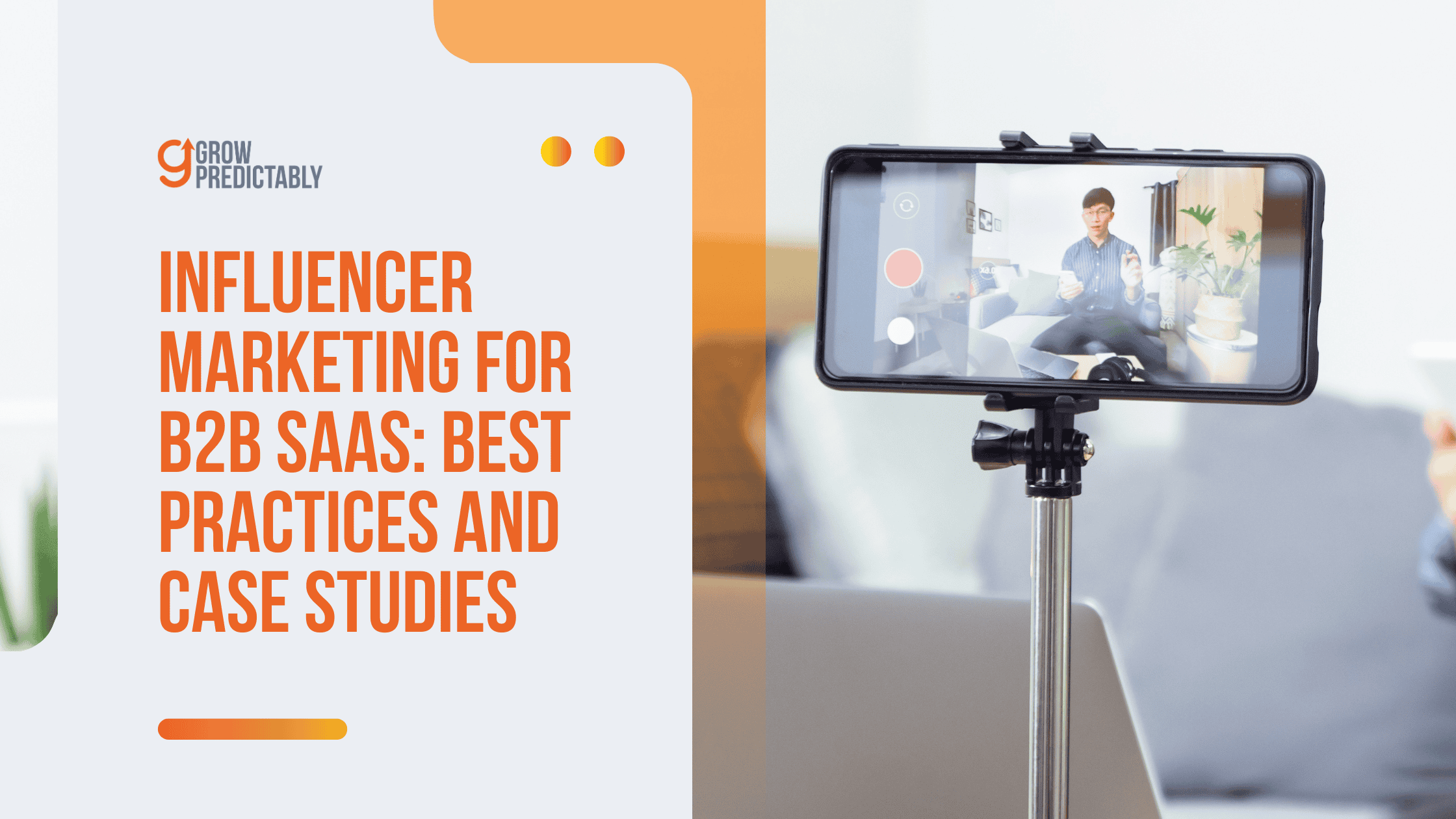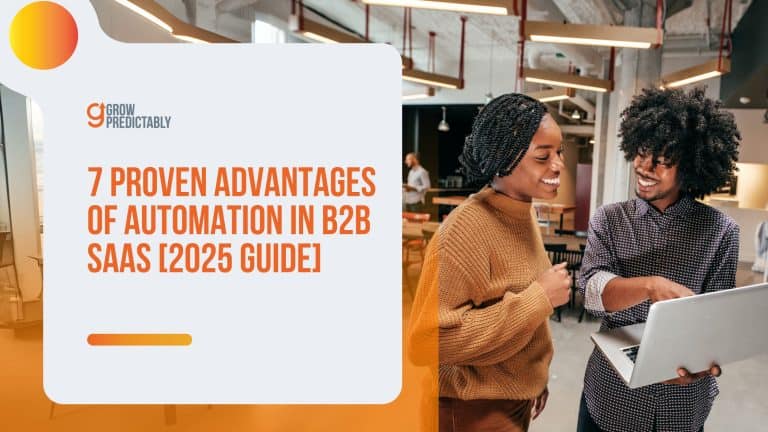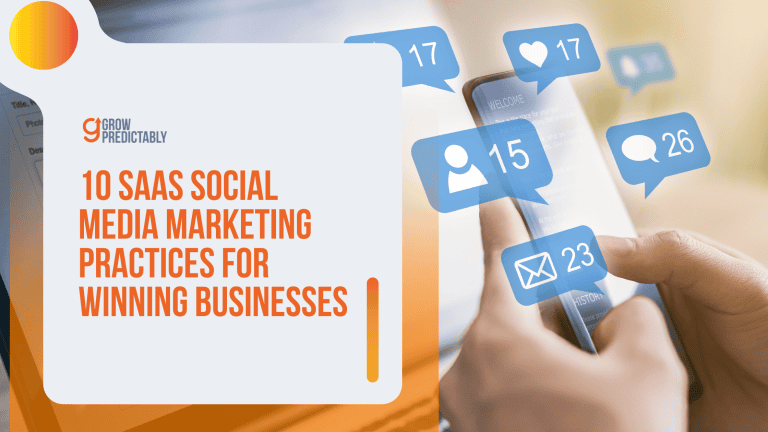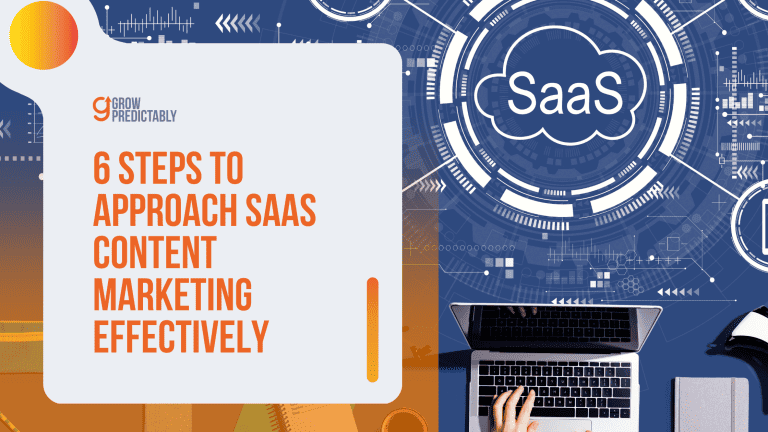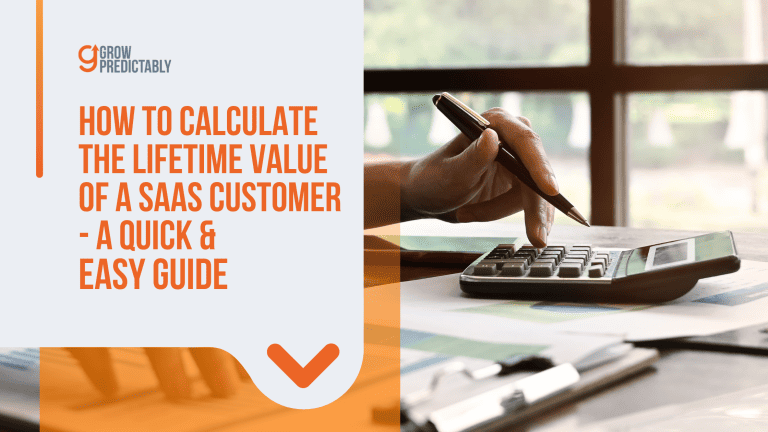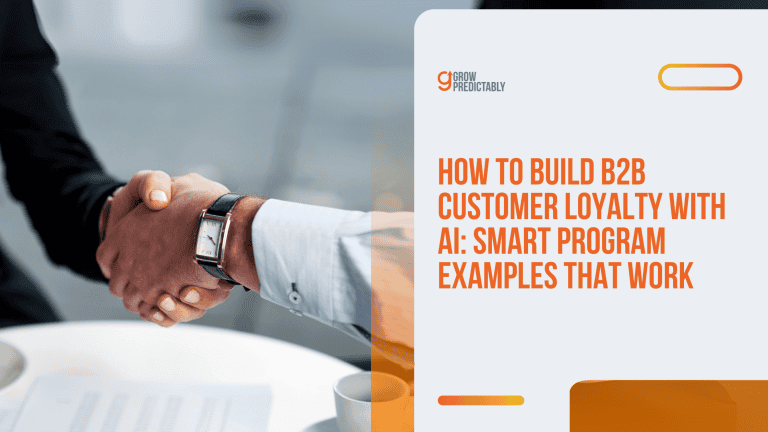Influencer Marketing for B2B SaaS: Best Practices and Case Studies
B2B SaaS execs often think influencer marketing is “not for us.”
Understandably, with the technical nature of the typical B2B target audience, today’s influencers may not always be the first option B2B SaaS executives turn to.
But it’s already delivering 11x ROI for companies in your space compared to ROI from banner ads. (Source)
When was the last time a LinkedIn post or boring webinar pulled those kinds of results?
This guide unpacks the exact strategies top SaaS marketers are using to win with influencer partnerships.
Ready to rethink what’s possible? Let’s go.
3 Key SaaS Influencer Marketing Strategies

Struggling to build authentic B2B influencer partnerships? Here’s how top SaaS brands succeed.
But first, you have to know that it’s not all about follower counts – it’s about strategic partnerships that resonate with your target audience.
Here’s what actually works in B2B SaaS influencer marketing strategy:
1. Pick Partners Based on Audience Alignment
Finding the right influencers can make or break your B2B SaaS marketing campaign.
Smart audience alignment is critical – you need partners who speak directly to your potential customers.
Start by mapping your ideal customer profile (ICP) against potential influencers’ audience demographics.
For instance, if you’re selling project management software to tech startups, you’ll want influencers who attract startup founders and product managers.
Don’t get caught up in follower counts.
A tech influencer with 20,000 engaged followers in your niche will deliver better results than a general business influencer with 200,000 random followers.
Here’s how to evaluate potential influencer partnerships:
- Analyze audience composition
- Check job titles and company sizes
- Look at industry focus and geographical location
- Review engagement patterns on B2B content
- Study content quality indicators
- Consistency of posting schedule
- Depth of expertise in the SaaS industry
- Response quality in comments and discussions
- Track record with other B2B partnerships
Remember: A smaller, well-aligned target audience that trusts the influencer’s recommendations is worth far more than a large, disengaged following.
2. Build Real Relationships First
Building genuine relationships with influencers is crucial for your B2B SaaS marketing success.
Cold outreach rarely works – you need to establish trust before proposing any partnerships.
As a SaaS marketer, you know that authenticity drives results.
That’s why you should spend 2-3 months genuinely engaging with potential influencer partners before making any business proposals.
Think of it like enterprise sales – you wouldn’t pitch a major client without proper relationship building first.
The same applies to influencer partnerships.
Here’s how to build meaningful connections with potential influencer partners:
- Engage meaningfully on their platforms
- Comment with specific insights about their content
- Share their posts with your own valuable perspective
- Join their online discussions or community events
- Demonstrate genuine interest in their expertise
- Create value before asking for anything
- Share their work with your network
- Connect them with relevant SaaS industry contacts
- Offer valuable insights from your SaaS business experience
- Highlight their work in your content when relevant
- Make real-world connections
- Attend industry events where they’re speaking
- Join their webinars and ask thoughtful questions
- Participate in their online communities
- Look for mutual connection opportunities
Remember: Rushing into partnership requests can damage potential relationships. Focus on building trust first.
3. Amplify Content Strategically
Getting maximum impact from your B2B SaaS influencer content requires smart amplification strategies for SaaS influencer marketing campaigns.
Your goal is to reach decision-makers across multiple touchpoints while maintaining consistent messaging.
It’s a given that collaborating with SaaS influencers can help amplify your reach effectively.
However, as a digital marketing agency or SaaS marketer, you know that content repurposing is crucial for ROI.
One piece of influencer content can turn into multiple assets that work across different platforms and audience segments.
Start with relevant influencers (micro-influencers) who have 10-50K followers in your niche.
They typically deliver better engagement rates and more reasonable partnership costs while you perfect your approach.
Here’s how to maximize your influencer content reach:
- Create versatile content packages
- Turn long-form videos into short clips
- Extract quotable moments for social posts
- Develop blog posts from webinar transcripts
- Create infographics from key statistics
- Support easy content distribution
- Prepare sized images for each platform
- Create pre-written social copy
- Design custom thumbnails and headers
- Package everything in shareable folders
- Time your content strategically
- Align with industry events
- Post during peak engagement hours
- Coordinate across multiple channels or social media platforms
- Plan for consistent content drops
Remember – authentic partnerships built on mutual value will always outperform transactional relationships focused solely on reach.
If you haven’t noticed yet, these strategies focus on how you can cultivate deep and authentic connections with your brand’s influencers, and how you can maximize the work that you do with them.
It’s not just about finding someone famous online to mention your brand; it’s about finding people who align well with the value you’re offering.
But of course, we don’t just stop at identifying the SaaS influencer marketing strategies that you need to focus on.
Let’s double down on the best practices that amplify your strategy’s impact.
3 B2B Influencer Marketing Best Practices to Keep
Influencer marketing isn’t just a B2C game – it’s a powerful tool for B2B SaaS marketers, too.
Focusing on influencer marketing for SaaS allows brands to establish authentic connections.
But to see real results, you need a strategy that goes beyond surface-level metrics and focuses on building authentic, high-impact connections.
This guide dives into three proven best practices for leveraging SaaS influencer marketing to grow your B2B brand.
1. Identify the Right Influencers for Your B2B SaaS
Finding a SaaS influencer isn’t just about star power – it’s about connecting with someone who speaks your product’s language.
Let’s skip the vanity metrics and focus on what really moves the needle.
First, get crystal clear on your technical niche.
A cybersecurity SaaS needs different voices than a productivity tool.
Use these targeted approaches:
- Platform Deep-Dive
- Search LinkedIn for thought leaders posting about your specific tech stack
- Monitor GitHub discussions to spot developers with strong followings
- Track SaaS industry hashtags on Twitter to find active tech commentators
- Quality Signals (Beyond Followers)
- Comment quality: Look for influencers whose posts spark meaningful technical discussions
- Content depth: Choose creators who explain complex features clearly
- Engagement ratio: Aim for 3%+ engagement on technical content
- Previous SaaS collaborations: Check their track record with similar products
- Verification Steps
- Run their content through BuzzSumo to verify consistent engagement
- Use Hootsuite’s analytics to check audience authenticity
- Attend virtual tech conferences where they speak to assess expertise
- Review their personal tech projects or contributions
Pro tip: Create a scoring system (1-5) for each potential B2B influencer:
- Technical knowledge of your niche
- Audience relevance
- Content consistency
- Engagement quality
- Brand alignment
Let’s say you run a B2B SaaS tool that helps project managers with all their project management needs, and you’re collecting a pool of influencers to partner with on TikTok.
Influencers like Melissa Blackmore (@melissakblackmore) are the ideal type of influencers to start your pool with.

As a career coach and project management expert, her content aligns with project management professionals, making her a valuable influencer for B2B SaaS brands that offer project management solutions.
Next up, we’ll show you how to turn these influencer relationships into powerful marketing partnerships that drive real user adoption.
Remember: An influencer with 10,000 engaged developers beats one with 100,000 passive followers every time.
2. Building Win-Win Partnerships
Strong partnerships start with a simple truth: mutual success breeds lasting relationships, especially when collaborating with SaaS influencers.
Let’s map out how to build partnerships that actually work, using the Customer Value Journey as our blueprint.
The journey kicks off with targeted outreach – think personal LinkedIn messages or warm email intros that show you’ve done your homework.
But here’s the key: lead with value before asking for anything. Share their content. Connect them with opportunities. Be genuinely helpful.
Once you’re engaging, focus on finding a common ground.
Just like what American educator, author, and businessman Stephen Covey said:
A win-win solution is not just about compromise, it’s about finding common ground.
Stephen Covey
Maybe you both serve small business owners or share a passion for sustainable practices. This alignment forms your partnership foundation.
The real magic happens in the small wins.
Start with a joint blog post or podcast appearance before jumping into bigger projects.
One of our clients landed a game-changing partnership by first hosting their future partner on a webinar that brought value to both audiences.
As trust builds, expand thoughtfully:
- Create exclusive content together
- Cross-promote to your respective email lists
- Develop co-branded offerings
- Share resources and insights regularly
Pro tip: Document everything. Clear agreements on deliverables, timelines, and revenue sharing prevent headaches later. But keep it flexible – the best partnerships evolve.
The end goal?
Turn partners into active advocates who naturally promote your brand because it genuinely helps their audience.
Netflix and Stranger Things creators did this brilliantly – both parties consistently champion each other because their success is intertwined.
Remember: true partnerships aren’t transactions. They’re relationships built on trust, mutual benefit, and consistent value exchange. Focus there, and the rest falls into place.
3. Crafting an Effective Content Distribution Plan
What’s the secret to content that actually gets seen?
It’s simple – a rock-solid distribution strategy that matches your content with the right eyeballs at the right time.
Here’s your battle plan:
- Map Your Distribution Channels
- Primary: LinkedIn company page + executive profiles
- Secondary: Industry-specific forums and Slack communities
- Tertiary: Partner co-marketing opportunities
- Content Type Selection
- Partner case studies (showcase real wins)
- Technical deep-dives (establish authority)
- Joint webinars (leverage combined audiences)
- Behind-the-scenes podcast episodes (humanize your brand)
- Strategic Timing & Frequency
- Post partner content during peak B2B hours (Tuesday-Thursday, 9am-2pm)
- Space out similar content types by 2 weeks
- Maintain 3:1 ratio of educational vs promotional content
- Amplification Tactics
- Get your partners’ sales teams sharing content
- Cross-post in relevant industry newsletters
- Repurpose long-form content into bite-sized LinkedIn posts
- Tag partner companies in social updates
There are also a number of tools that supercharge content distribution for their users.
One example of such tools is the social media management tool Hootsuite.

Hootsuite supports scheduling, monitoring, and engaging on multiple platforms in one dashboard.
Hootsuite’s analytics and team collaboration features make it highly versatile.
Pro tip: Build a content activation checklist for your team. Every piece should hit at least 3 distribution channels or social media platforms with custom formatting for each platform.
Your next move? Time to pick the perfect tech stack to automate this distribution machine. But that’s a story for another section.
Platforms and Tools for Your SaaS Influencer Marketing Strategy
If we’re gonna talk platforms, LinkedIn would be your most promising option, with a majority of marketers rating it as their top platform for marketing. (Source)
The real magic happens through thought leadership content, live streams, and newsletter partnerships.
Smart SaaS brands like Gong knock it out of the park by teaming up with sales leaders who share tactical tips through LinkedIn Live sessions.
Just like what Hootsuite did in their ‘The Role of Sales Development in the SaaS Sales Cycle’ meet in the example below.

Podcasts pack a serious punch, too.
Shows like SaaS Heroes and The Growth Hub pull 50K+ monthly listeners actively hunting for software solutions.
Get this: podcast guests typically share their episodes 4x more than blog content, giving you an organic reach boost.
For tracking and relationship management:
- GRIN excels at campaign analytics and ROI tracking (image below)
- IZEA specializes in matching brands with tech-focused creators
- CreatorIQ brings AI-powered insights to predict influencer performance

Here’s where things get interesting: TikTok’s B2B scene is exploding.
Companies like Monday.com and HubSpot are crushing it with quick-hit tutorial content from tech influencers.
Their 60-second demos grab 3x more engagement than traditional product videos.
Quick power tip: Use LinkedIn for authority building, podcasts for deep dives, and TikTok for snackable product showcases. Match each platform’s strengths to different parts of your funnel.
Want to see these platforms in action? Stick around – we’ve got real influencer marketing campaign breakdowns coming up that’ll show you exactly how companies like Slack and Asana are winning the influencer game.
Emerging Platforms for B2B SaaS Influencer Marketing and How You Can Leverage
TikTok and Instagram are reshaping B2B SaaS marketing in surprising ways.
While LinkedIn remains the go-to channel, forward-thinking SaaS companies like HubSpot and Slack have found gold on these newer social media platforms.
TikTok’s B2B success lies in its short-form video format, and its user base is growing, including decision-makers and relevant influencers in B2B buying teams. (Source)
Zoom’s #MeetHappy campaign hit 2.4 million views by showing quirky remote work scenarios, proving that serious products can thrive with light-hearted content. The key?
Creating authentic, educational content that doesn’t feel like a sales pitch.
Instagram’s visual storytelling works particularly well for SaaS dashboard demos and behind-the-scenes team content.
Salesforce nails this approach with their #SalesforceOhana series, mixing product updates with employee stories.
Quick wins for these platforms:
- Create 15-second product tutorials
- Share customer success stories via Reels
- Use trending sounds/filters creatively
- Post employee takeovers showing real product use
- Leverage platform-specific hashtags (#TechTok, #SaaSTips)
The most successful B2B brands on these platforms focus 80% on education/entertainment and 20% on product promotion.
This ratio keeps followers engaged while building trust naturally.
Remember: Your competitors probably haven’t mastered these platforms yet.
That’s your opportunity to stand out and connect with decision-makers where they actually spend their time, not just where they work.
The Best Influencer Marketing Platforms to Use

Managing B2B influencers without the right tools is like running a restaurant with a broken stove – ineffective and disorganized.
Here’s your toolkit for smooth operations:
Creator Management Platforms (CMPs):
- AspireIQ, CreatorIQ, or Upfluence to handle your talent pool
- Store contracts, briefs, and performance data in one place
- Quick filters to match creators with influencer marketing campaigns based on metrics
Analytics & Tracking:
- Traackr for deep audience insights and fraud detection
- Social Blade to verify growth patterns and engagement rates
- UTM parameters + Google Analytics 4 for sales attribution
Communication Systems:
- Monday.com or ClickUp for influencer marketing campaign workflows
- Slack channels for quick creator check-ins
- Asana for content approval processes
Payment & Compliance:
- PayPal Business for structured payments
- DocuSign for legally-binding agreements
- FTC compliance checkers for proper disclosure
Pro Tips:
- Set up automated alerts for engagement drops
- Use AI-powered sentiment analysis on creator comments
- Build custom dashboards combining data from multiple tools
Great tools amplify strategy, but they don’t replace genuine relationships.
Use them to support, not substitute, personal connections with creators.
Once you’ve mastered these tools, you’ll want to measure their impact – we’ll tackle ROI calculations in the next section.
Challenges and Solutions in B2B SaaS Influencer Marketing

B2B SaaS influencer marketing hits different snags than its B2C cousin.
Here’s what trips up most companies – and how to dodge these bullets in influencer marketing for SaaS.:
- The “Celebrity Syndrome” Trap
- Problem: Companies chase big names without checking domain expertise
- Fix: Focus on tech leaders, industry veterans, and subject matter experts who actually use your product
- Example: IBM partners with developers who’ve built successful projects using their cloud services
- Authenticity vs. Control Balance
- Problem: Over-scripted content sounds fake, but total freedom risks mixed messaging
- Fix: Create collaborative briefs that blend key points with the influencer’s voice
- Example: Salesforce lets their MVP advocates share personal wins while highlighting specific features
- ROI Measurement Headaches
- Problem: Traditional metrics like reach don’t capture B2B’s longer sales cycles
- Fix: Track multi-touch attribution across:
- Content engagement rates
- Sales pipeline influence
- Deal acceleration metrics
- Technical adoption rates
- Content Format Misalignment
- Problem: Using flashy B2C-style content for serious B2B decisions
- Fix: Create technical deep-dives, implementation guides, and ROI calculators
- Example: HubSpot partners with industry experts for detailed case studies and technical workshops
Quick Win: Start with a pilot program featuring 2-3 industry experts who already use your product.
Track their content’s impact on technical adoption and sales conversations over 90 days.
Later, we’ll check out how Monday.com turned its power users into authentic advocates, driving enterprise adoption through technical storytelling.
Case Study – Monday.Com
Monday.com’s collaboration with Ann Handley stands out as a masterclass in B2B SaaS influencer marketing.
The project management platform partnered with Handley, a respected content marketing expert, to create a series of LinkedIn posts and video content about remote team productivity.

Key success factors for working with SaaS influencers::
- Authentic alignment: Handley already used Monday.com, making her endorsement credible
- Content focus: Rather than promotional content, they created practical remote work guides
- Distribution strategy: Used Handley’s 500K+ LinkedIn following plus Monday.com’s channels
- Clear metrics: Generated 2.5M impressions and 12K trial signups in 3 months
Success ingredients:
- Topic expertise match between brand and influencer
- Multi-channel promotion (email, social, paid)
- Lead scoring system to identify high-intent prospects
- Post-event nurture sequences
Pro tip: Start small with micro-influencers in your niche. Test different content formats with 3-4 creators before scaling up investment. Track both engagement metrics and bottom-line impact through unique campaign codes.
Remember: The goal isn’t just reach—it’s building trust through genuine expert partnerships that drive real SaaS business outcomes.
Measuring Success for B2B SaaS Influencer Marketing
Throwing money at influencer marketing campaigns without solid tracking wastes resources and misses growth chances.
SaaS companies can overcome this by setting clear KPIs and monitoring influencer effectiveness.
Here’s how smart B2B companies measure SaaS influencer marketing wins:
Key Performance Indicators (KPIs):
- Direct lead volume from influencer content
- Marketing Qualified Lead (MQL) conversion rate
- Average deal size from influencer-sourced leads
- Influenced pipeline revenue
- Content engagement metrics (shares, comments, saves)
Pro Tips for Advanced Tracking:
- Set Up Multi-Touch Attribution
- Use UTM parameters for each influencer touchpoint
- Track leads across different influencer marketing campaign elements
- Measure direct vs. assisted conversions
- Leverage Analytics Tools
- Google Analytics for traffic and behavior flows
- LinkedIn Campaign Manager for B2B engagement
- HubSpot for lead source tracking
- Tableau/PowerBI for custom ROI dashboards
- Calculate True ROI
Base formula: (Revenue from influenced deals – Campaign costs) / Campaign costs x 100
Advanced formula:
- Include lifetime value projections
- Factor in sales cycle length
- Account for brand lift value
Smart move: Create monthly scorecards comparing influencer performance against other channels, which helps justify budget and optimize spending.
Remember: Focus on metrics that connect directly to revenue. Vanity metrics like follower count mean nothing if they don’t drive qualified leads.
The Evolving Landscape of Influencer Marketing in SaaS
SaaS influencer marketing is shifting from polished corporate content to raw, technical authenticity.
Software buyers now trust tech practitioners and developers who share real-world implementation stories over traditional thought leaders.
Key shifts reshaping the space:
- Technical Community Leaders
- GitHub stars and Stack Overflow contributors becoming micro-influencers
- Engineers with hands-on product experience gaining more trust than executives
- Code walkthrough videos and debugging sessions replacing staged demos
- Platform-Specific Changes
- LinkedIn’s creator mode pushing technical professionals into content creation
- Discord communities enabling direct access to product builders
- Developer-focused platforms like Dev to rising in importance
- Content Evolution
- Live coding sessions and technical workshops replacing generic webinars
- Short-form video tutorials on TikTok/Instagram reaching younger developers
- Open source contribution stories driving authentic engagement
- Measurement Refinements
- Focus on qualitative metrics like implementation success stories
- Tracking community contribution quality over follower counts
- Measuring actual product adoption through influencer-shared tutorials
Looking ahead, we’ll see:
- AI tools helping creators produce technical content faster
- More emphasis on practitioner credentials over social metrics
- Rise of developer advocates as key distribution channels
- Integration of community building with influencer programs
Pro tip: Build your program around active practitioners in your product category. Their hands-on experience carries more weight than general tech influencers.
Key Takeaways
Influencer marketing takes dedication, but it’s worth every bit of effort.
Start by finding SaaS influencers or influencers that match your values and audience as a SaaS business.
Draft clear partnership agreements before getting into influencer marketing partnerships, focus on genuine value creation with SaaS influencers, and measure results rigorously using the most ideal influencer marketing platform that suits you.
Key points to remember:
- Partner fit matters more than follower count in SaaS influencer marketing campaigns
- Track ROI using custom links and promo codes
- Build long-term relationships over quick wins
- Test different content formats and engagement strategies
- Always disclose partnerships transparently
Ready to start? Here’s your action plan:
- List 5 dream partners
- Create your partnership pitch deck
- Set up tracking systems
- Draft content guidelines
- Build your outreach calendar
Remember: successful influencer marketing partnerships grow from authenticity and mutual benefit. Take that first step – your perfect brand partner is waiting.

